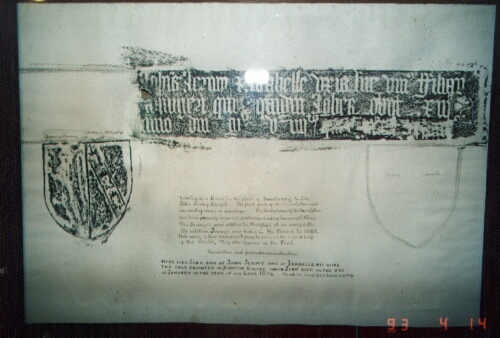
Rubbing of the partly defaced brass to John Jermy, and Isabelle Hopton.
It originally stated: Orate pro animabus Johannis Jermy et Isabelle uroris sue, unius filiarum Johannis Hopton Armigeri, qui quidem Johannis obiit xiii die Januarii Anno Domini MDiiii. Quorum animabus propicietur Deus Amen.
"Pray for the souls of John Jermy and Isabelle his wife, one of the daughters of John Hopton, knight, which same John died the thirteenth day of January in the year of our Lord 1504, on whose souls may God have mercy. Amen."
William Dowsing, the Norfolk iconoclast, visited Metfield on 30 August 1644. In addition to other defacements in the church, he ordered the removal of portions of the above inscription. Initially, Thomas Jermy, Esq., the eldest son of Sir Thomas Jermy, K.B. refused to accede to Dowsing's demands, but eventually he had to aquiesce.
William Dowsing's diary entry reads:
269. Mettfield [Metfield], Aug. 30. In the church, was Peterís keys, and the Jesuitís badge, in the window; and Mary on the top of the roof. I. for Jesus, H. for Hominum, and S. for Salvator; and a dove for the Holy Ghost, in wood; and the like in the chancel; and there, in brass, Orate pro animabus; and the steps to be levelled, by Sept. 7. Mr. [blank] Jermin, the Gent. in the town, refused to take the inscription, as the churchwarden informed, whose name is [blank].
The left hand quarter of the inscription plate was cut away to remove the Orate pro animabus, but the final Quorum animabus propicietur Deus Amen was marked around with two grooves and then defaced.
Ref: Cooper, T (Ed). 2001. The Journal of William Dowsing - Iconoclasm in East Anglia during the English Civil War.
| Previous | Thumbnails | Next |